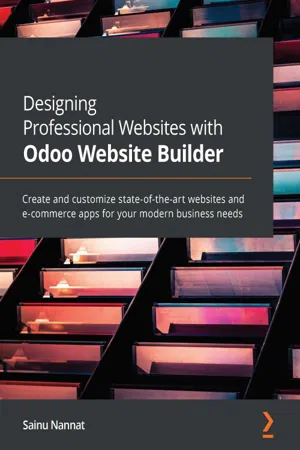
- 390 pages
- English
- ePUB (mobile friendly)
- Available on iOS & Android
Designing Professional Websites with Odoo Website Builder
About this book
A practical guide to crafting elegant, intuitive, and customer-friendly websites to deliver a high-quality user experience using the powerful features of the Odoo website builderKey Features• Understand website creation using the Odoo website builder and learn how to make the most of it• Extend your website by configuring the additional tools and functional options• Learn about manageability and real-time functioning of the website using various operational toolsBook DescriptionThe Odoo website builder is an operational tool in the Odoo platform that allows you to design, develop, and manage a website. This book introduces and explains all the features of the Odoo website builder that will help you to be more productive while creating websites. The book starts with an overview of the Odoo website builder, its functionalities, and the tools it offers. Using descriptive illustrations and practical examples, you'll gain detailed insights into the block operations of the Odoo website builder and learn how to work with structure blocks, features blocks, and dynamic content blocks. As you advance, you'll discover how to use the HTML, CSS, or JS editor in Odoo website builder applications for customization. This Odoo book will take you through the different aspects of website building and show you how e-commerce websites can be designed and developed using website builder applications. You'll build a website, manage it, and run a discussion forum in Odoo using the website builder, and apply your knowledge to add a live chat tool that can be incorporated into your website using the Odoo website builder. By the end of this book, you'll have gained a solid understanding of the Odoo website builder and be able to leverage its features to develop your own website.What you will learn• Find out how to implement structure blocks while developing a website• Work with dynamic content blocks and inner content blocks in the Odoo website builder• Use an HTML, CSS, or JS editor in the Odoo website builder to customize applications• Create and design a blog with the Odoo website builder• Build a fully functional e-commerce website and a discussion forum using the Odoo website builder• Track visitors on the website and understand the live chat tool and its functionalityWho this book is forThis book is for Odoo users, functional consultants, techno-functional consultants, web designers, and anyone looking to create impressive websites. Odoo developers will also find the book useful for building their website for the end user. Basic functional knowledge of Odoo is all that you need to get started with this book.
Frequently asked questions
- Essential is ideal for learners and professionals who enjoy exploring a wide range of subjects. Access the Essential Library with 800,000+ trusted titles and best-sellers across business, personal growth, and the humanities. Includes unlimited reading time and Standard Read Aloud voice.
- Complete: Perfect for advanced learners and researchers needing full, unrestricted access. Unlock 1.4M+ books across hundreds of subjects, including academic and specialized titles. The Complete Plan also includes advanced features like Premium Read Aloud and Research Assistant.
Please note we cannot support devices running on iOS 13 and Android 7 or earlier. Learn more about using the app.
Information
Section 1: An Overview
- Chapter 1, Introduction to Odoo and Its Website Builder
- Chapter 2, The Website Builder in Action
Chapter 1: Introduction to Odoo and Its Website Builder
- An introduction to Odoo
- An overview of the Odoo platform
- A brief insight into the Odoo website builder tool
An introduction to websites
An overview of Odoo and its operational aspects
Table of contents
- Designing Professional Websites with Odoo Website Builder
- Contributors
- Preface
- Section 1: An Overview
- Chapter 1: Introduction to Odoo and Its Website Builder
- Chapter 2: The Website Builder in Action
- Section 2: Website Builder in Depth
- Chapter 3: An Introduction to Blocks
- Chapter 4: Design Using Features Blocks
- Chapter 5: Designing a Website using Dynamic Content
- Chapter 6: Inner Content Block Tools
- Chapter 7: HTML/CSS/JS Editor
- Section 3: Practical Tools
- Chapter 8: Creating Your Own Blog Pages
- Chapter 9: Go Live with Your E-Commerce Website
- Chapter 10: A Discussion Forum for Your Clients
- Chapter 11: Tracking Your Website with Odoo
- Chapter 12: Drafting a Contact Page
- Chapter 13: Communicating with Live Chat
- Assessments
- Other Book You May Enjoy